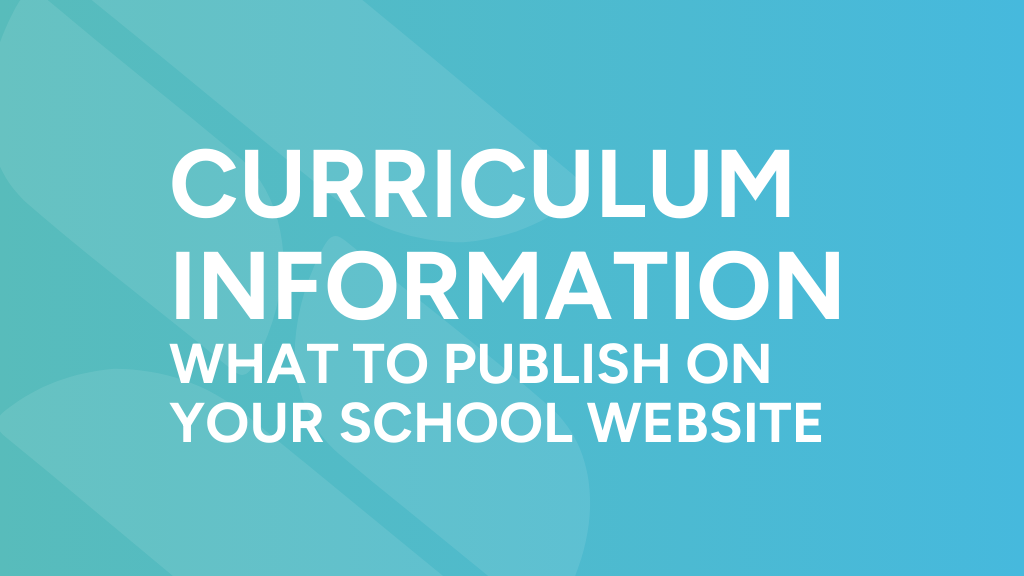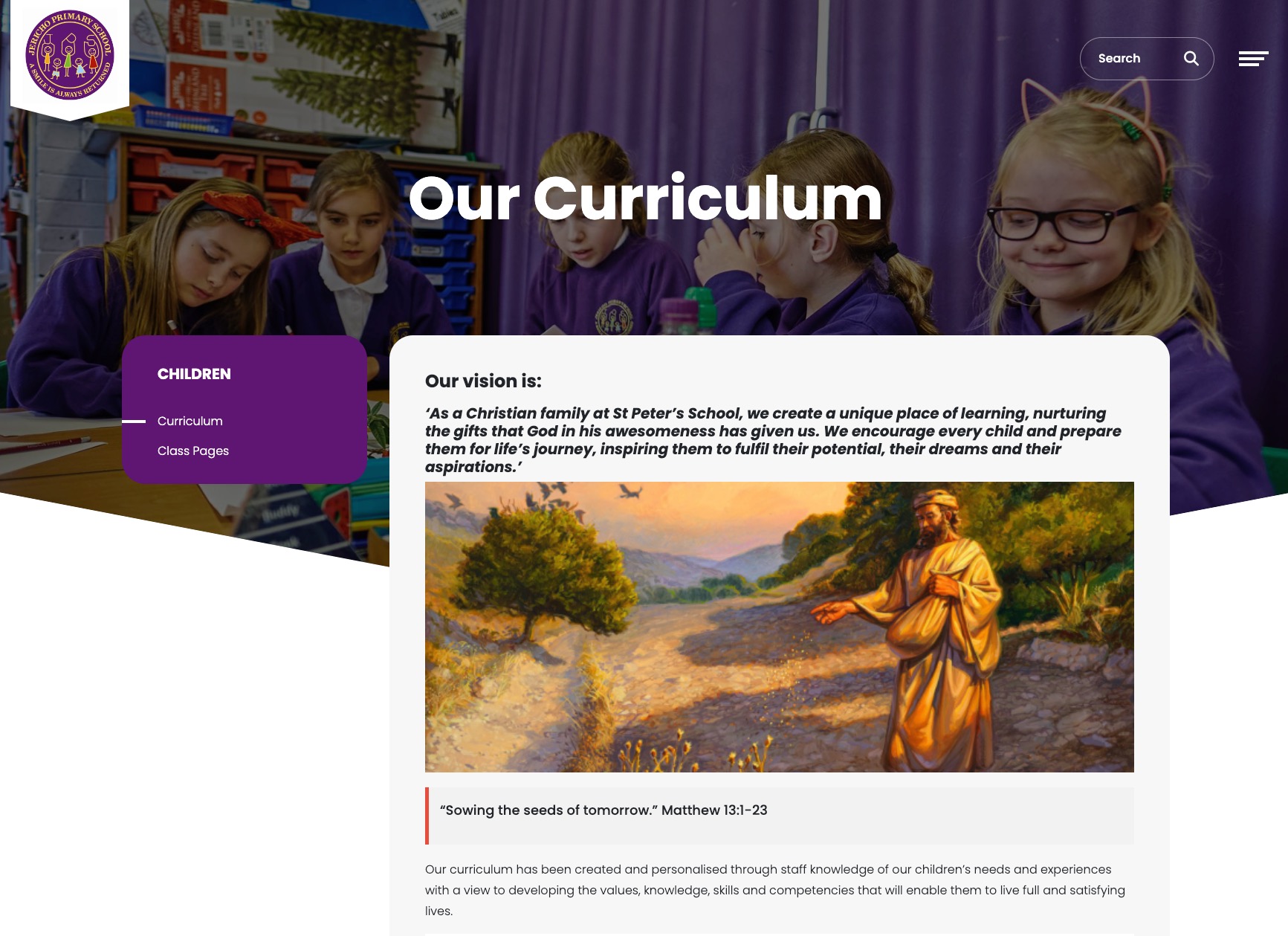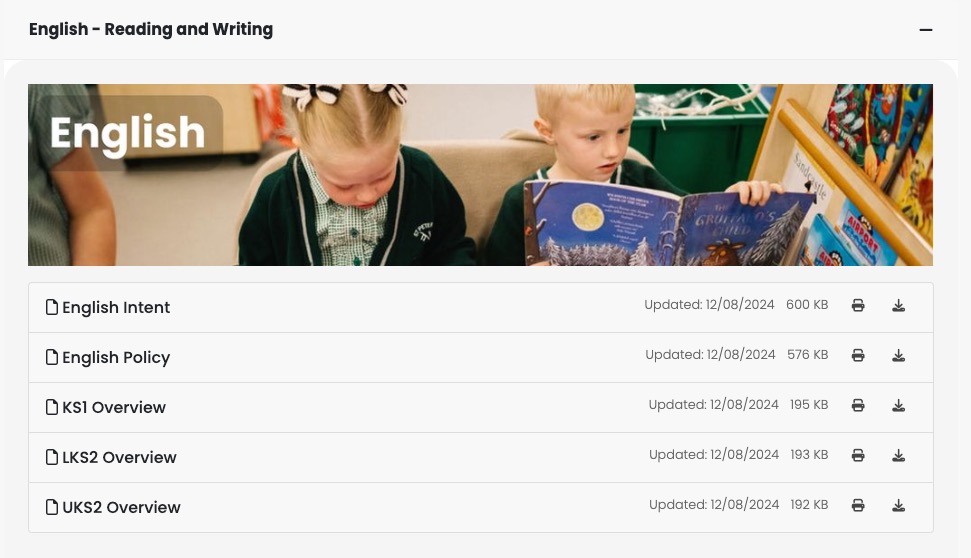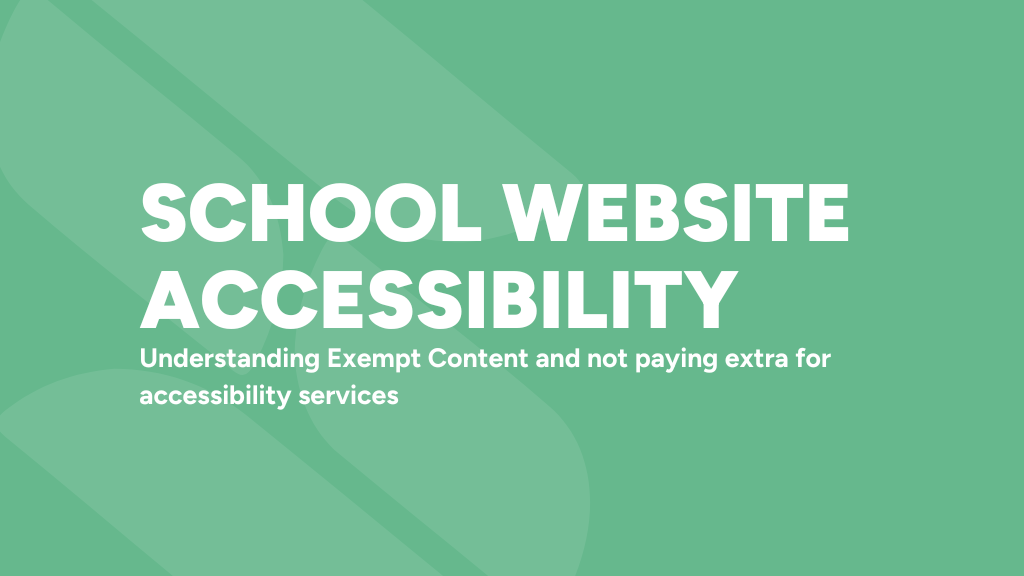Curriculum Information and What to Publish on Your School Website
Curriculum Information and What to Publish on Your School Website
Curriculum Information and What to Publish on Your School Website

Curriculum information is one of the most critical sections on any school website. It helps parents and carers understand what their children will be learning. But, it also serves as an essential tool for compliance with the Department for Education’s (DfE) statutory guidelines. With increasing scrutiny around curriculum transparency, ensuring this section of your website is up-to-date and engaging has never been more important. This post will break down the latest school website requirements for curriculum information and what to publish on your school website. We’ll also offer practical advice on ensuring your content meets statutory guidelines while engaging your community.
Why Curriculum Information Matters
The DfE requires all schools to publish detailed information about the content of their curriculum. This information serves two vital purposes:
- Compliance: Schools must meet specific statutory obligations, ensuring they provide transparency about what is being taught and how the school supports different learners, particularly those with special educational needs or disabilities (SEND).
- Engagement: Curriculum information is a tool to engage parents, carers, and students. It provides insights into what is taught and offers opportunities for families to become involved in their children’s education, supporting learning beyond the classroom.
Statutory Curriculum Information: What All Schools Must Publish
All schools are required to publish detailed information about their curriculum on their website. This must include:
- The content of the curriculum for each academic year for every subject: This includes mandatory subjects such as religious education (RE). Even if a subject is taught as part of another subject or under a different name, it must still be listed.
- Parental Rights for Religious Education: Schools must inform parents and carers that they have the right to withdraw their child from some or all of religious education classes.
- Curriculum Access: Details must be provided on how parents, carers, and the public can find out more about the school’s curriculum, such as contact information or additional resources.
- Accessibility Plan: Schools must publish an accessibility plan detailing how they will improve curriculum access for students with disabilities or SEND over time.
Phase-Specific Requirements
Certain requirements depend on the educational phase your school covers. Here’s a breakdown of what additional information is required for different stages:
Key Stage 1 (Primary Schools)
For schools with Key Stage 1 provision, you must also publish:
- Phonics and Reading Schemes: A list of the phonics or reading schemes used by the school must be included on the curriculum page. This ensures parents and carers can access information on how early literacy is supported.
Key Stage 4 (Secondary Schools)
Schools with Key Stage 4 provision must publish:
- Key Stage 4 Courses: A list of all courses offered at Key Stage 4, including GCSEs, should be provided. This allows students and parents to make informed decisions when selecting their options.
Where applicable, schools must also list any 16 to 19 qualifications offered, such as A-Levels or vocational courses.
Music Curriculum and Music Development Plan
All schools must publish their approach to teaching music, as well as a music development plan. This information helps demonstrate how the school prioritises music education and supports student development in this area.
Requirements for Academies
Academies, including those with 16 to 19 provision, have additional requirements:
- Relationships and Sex Education Policy: Academies must publish a policy on relationships education or relationships and sex education (RSE). This policy should be developed in consultation with parents and carers, ensuring that it meets the needs of the pupils and the wider community the academy serves.
- 16 to 19 Study Programmes: If your academy offers post-16 education, you must also publish details about how the curriculum meets the 16 to 19 study programme requirements. This ensures transparency and helps students make informed choices about their post-16 education pathways.
Special Considerations: Accessibility and Inclusivity
One of the most important aspects of your curriculum information is how it addresses accessibility. In compliance with the Equality Act 2010 and the Special Educational Needs and Disability Regulations 2014, schools must provide information about how they ensure the curriculum is accessible to students with disabilities or SEND.
The school’s accessibility plan should outline:
- How the school ensures all pupils, including those with SEND, can fully participate in the curriculum.
- Plans for making the curriculum more accessible over time, such as investing in technology, training for staff, or curriculum adaptations.
Publishing this information not only ensures compliance but also reassures parents and carers that your school is committed to inclusive education.
Displaying Curriculum Information on Your School Website

How your curriculum information is displayed on your website can greatly affect its effectiveness. Here are some practical tips to ensure your content is accessible, engaging, and compliant:
- Dedicated Curriculum Page: Create a dedicated section for your curriculum on the website, making it easy to find. Consider breaking down the curriculum by key stages or subjects, so visitors can quickly navigate to the information they need.
- Use Multimedia: Engage your audience by using more than just text. Incorporate images, videos, or infographics that showcase aspects of the curriculum in action. For example, you could include photos from a recent history project or short videos of students participating in a science experiment.
- Balanced Detail: When publishing curriculum content, strike a balance between too little information and too much. You want to provide enough detail for parents, carers, and inspectors to understand what is being taught without overwhelming them.
- Termly Curriculum Plans: Many schools publish termly curriculum plans to give parents and students a more detailed view of what each class will be covering. These plans can include topics, learning objectives, and key skills. Write in a way that is accessible to a broad audience.
- Blogging to Showcase Curriculum: Regular blog posts are a great way to highlight specific aspects of your curriculum in action. For example, you might write a blog post on how your Year 6 students are engaging with the World War II topic in history or how your Key Stage 1 pupils are exploring phonics. This not only keeps your curriculum pages dynamic but also provides insights into your school’s educational ethos.
- Link to Additional Resources: Link to additional resources, such as external curriculum frameworks, interactive learning tools, or national education standards. This allows parents and carers to explore the curriculum in more depth if they wish.
Why This Curriculum Page is a Great Example
When building a curriculum section for your school website, it’s important to consider both compliance with statutory requirements and the overall experience for visitors. Jericho Primary School’s curriculum page is a great example of how schools can effectively structure their content to meet the needs of parents, carers, inspectors, and students alike.
NOTE: This is an example site used to demonstrate best practice.
Here are some key reasons why this page stands out:
1. Clear Structure and Navigation
The page is neatly organised, with separate sections for each year group and subject. This makes it easy for visitors to find the exact information they are looking for without getting overwhelmed. The page includes clickable links that expand into detailed information, ensuring that the content is comprehensive yet accessible.
Why this matters: A well-structured page with intuitive navigation enhances the user experience and makes it easier for parents, carers, and inspectors to find relevant curriculum information quickly.
2. Detailed Curriculum Information
Each section provides detailed information about the curriculum for every subject in every year group. This goes beyond simply listing topics by clearly explaining what pupils will be learning in each area and how it ties into the school’s overall educational goals.
Why this matters: Providing detailed descriptions of what students will be learning shows a commitment to transparency and helps parents and carers understand the depth of education offered at each stage. It also meets the requirement to publish the content of the curriculum in each academic year for every subject.
3. Balanced Approach to Content
The page balances the amount of detail provided. It doesn’t overwhelm visitors with too much information, nor does it offer too little. It provides a comprehensive overview of the subjects taught while remaining engaging and easy to read.
Why this matters: Striking the right balance between providing detailed content and keeping it concise is crucial. Schools need to provide enough information to satisfy statutory requirements and offer insight into their curriculum without overwhelming the audience with excessive details.
4. Use of Visual Aids
Jericho Primary School’s curriculum page includes visual elements like diagrams and colour-coded sections, which help break up the text and make the content more visually engaging. These elements guide visitors’ eyes to key areas and improve the overall readability of the page.
Why this matters: Visual aids, such as infographics, images, or diagrams, help communicate complex information in a more digestible and appealing way. Incorporating these elements can make the curriculum content more engaging and easier for users to understand.
5. Easy Access to Further Information
The page provides links to additional resources, making it easy for parents, carers, and members of the public to find out more about the curriculum. This includes how to contact the school for more detailed inquiries, which meets the requirement to explain how parents and the public can find out more about the curriculum.
Why this matters: Providing contact information or additional resources helps visitors take further steps if they need more details or clarification, enhancing engagement and ensuring transparency.
6. Inclusion of Phonics and Reading Schemes
For Key Stage 1, the school includes a clear list of the phonics and reading schemes in use. This meets the statutory requirement for schools with Key Stage 1 provision to publish a list of any phonics or reading schemes used.
Why this matters: Including this information ensures that schools meet specific curriculum publishing requirements for Key Stage 1 while also helping parents understand how their child will be supported in early literacy.
Using Document Groups to Display Curriculum Information
One of the standout features of Jericho Primary School’s curriculum page is the use of Document Groups to organise and display important documents related to specific subjects, such as English. The school has divided the content into clearly labelled sections: Intent, Policies, and Key Stage Overviews, which are all embedded directly on the page.

1. Clear Presentation of Curriculum Intent
In the English section, the school provides a document outlining the Intent of the English curriculum. This document sets out the educational goals, outlining what the school aims to achieve through its English curriculum. This gives parents and inspectors a clear understanding of the school’s approach to teaching the subject and how it aligns with broader educational outcomes.
Why this matters: The use of an Intent document ensures transparency and allows schools to demonstrate how their curriculum supports overall learning objectives. It also reflects the importance of having a clear and focused strategy for each subject, which is a key component of Ofsted inspections.
2. Embedded Policies
The school also uses Document Groups to embed relevant Policies, such as those that detail how English is taught, assessment approaches, and any subject-specific policies that guide the curriculum. This ensures that all the necessary documentation is easily accessible in one place.
Why this matters: Including policies directly in the curriculum section ensures compliance with statutory requirements and offers clear insights into how the curriculum is implemented. This reduces the need for visitors to search elsewhere on the website for related information.
3. Key Stage Overviews
Another important feature is the inclusion of Key Stage Overviews. These documents provide an in-depth look at what is being taught at each key stage, detailing the topics covered, the skills students will develop, and how learning is assessed. For example, in the English section, the Key Stage Overviews break down learning into manageable segments, giving a clear roadmap for parents and carers to follow.
Why this matters: Providing detailed Key Stage Overviews helps parents and carers understand the progression of learning through the years, from the foundational skills in early key stages to more complex skills in later stages. This ensures transparency and helps answer questions about how the curriculum evolves as students progress through the school.
4. Organised and Easily Accessible Content
Using Document Groups makes the page both visually organised and functional. Visitors can easily navigate between different sections without being overwhelmed by large amounts of text. The embedded documents are downloadable, allowing for easy access to key information.
Why this matters: The structured and embedded document approach makes the curriculum page more user-friendly. This allows visitors to easily find and download key curriculum-related documents. This is especially useful for parents, inspectors, and other stakeholders who need access to detailed and specific information.
Special Advice for Multi Academy Trusts (MATs)
For Multi Academy Trusts (MATs), managing curriculum information across multiple schools can be streamlined by using centralised tools like Schudio’s ‘Shared Document Groups’. MATs can standardise the approach to curriculum publishing while allowing individual schools to tailor content to their unique context.
- Central Curriculum Framework: Develop a central curriculum framework that all schools within the trust can adopt. This ensures consistency in key areas. But, it still allows individual schools to make adjustments based on their student needs and local context.
- Efficient Updates: Use centralised management tools to update curriculum information across all school websites simultaneously, ensuring compliance and consistency without duplication of effort.
- Customisation by School: While a central framework ensures consistency, schools within the MAT can still personalise their curriculum content by including local projects, partnerships, or case studies that reflect their specific community.
Conclusion
Publishing clear and detailed curriculum information on your school website is essential to meet the latest school website requirements. Whether you are a maintained school, academy, or part of a Multi Academy Trust, ensuring your curriculum information is accessible and transparent will not only keep you compliant with DfE guidelines but also showcase the unique strengths of your school’s educational offering.
Set up detailed class or subject pages on your school website. Use features like tabs for timetables, topic overviews, staff profiles, and photo galleries, can be time-consuming at first. However, once in place, it becomes straightforward to maintain if updated regularly.
Managing this content efficiently allows you to keep it dynamic and relevant, ensuring ongoing engagement with parents and carers. This section of the website not only complies with statutory requirements. It becomes a powerful tool for showcasing your school’s curriculum and fostering a strong connection with the community.








